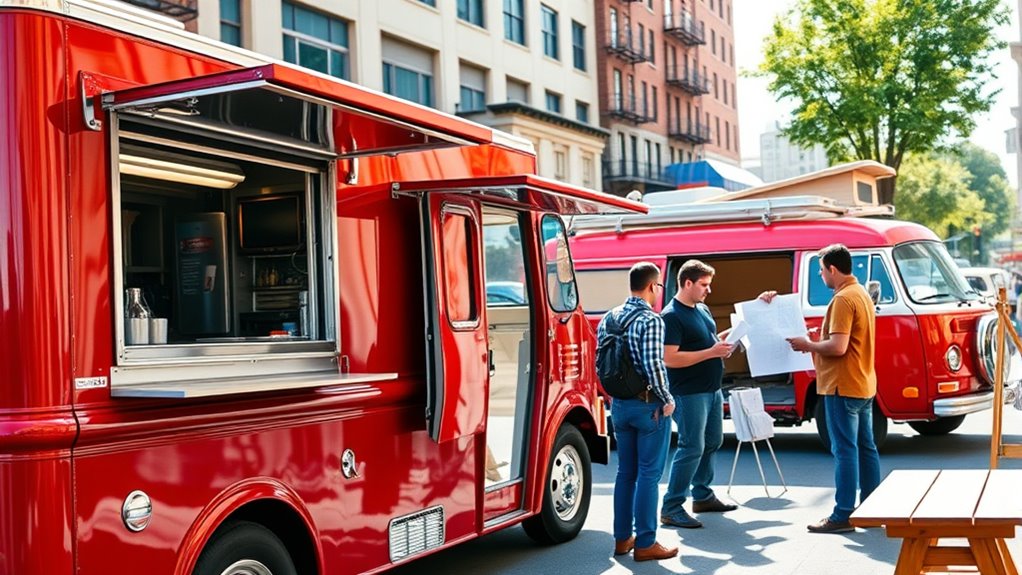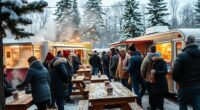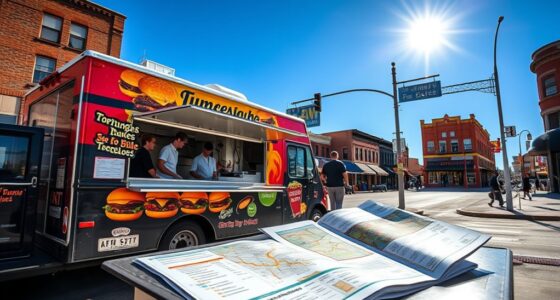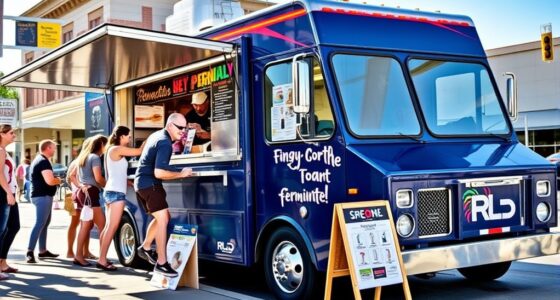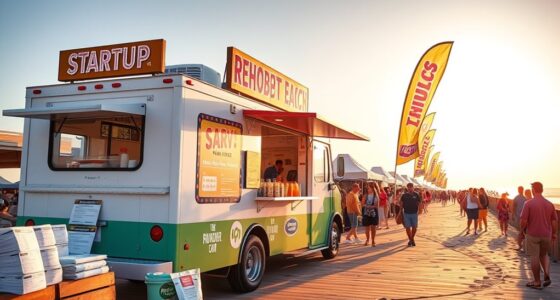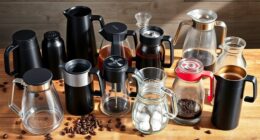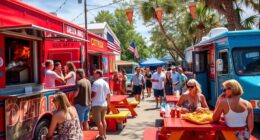Choosing between buying or building your own food truck depends on your budget, desired customization, and timeline. Buying saves time and initial costs, but limits unique features. Building allows full control over design and quality, although it takes longer and can be more expensive. Consider your long-term growth plans, maintenance needs, and brand vision. If you want a smoother start or more details, there’s plenty more to explore as you plan your food truck journey.
Key Takeaways
- Buying a pre-made truck offers quicker deployment and lower initial costs, while building allows full customization and branding control.
- Building a truck provides tailored features and layout optimization but generally takes more time and involves higher upfront investment.
- Purchasing a truck minimizes delays related to permits and regional regulations, enabling faster market entry.
- Building your own truck supports long-term scalability and flexibility for menu updates and operational growth.
- Buying is suitable for those prioritizing speed and budget, whereas building suits those seeking personalized design and specific equipment needs.
Cost Considerations and Budgeting
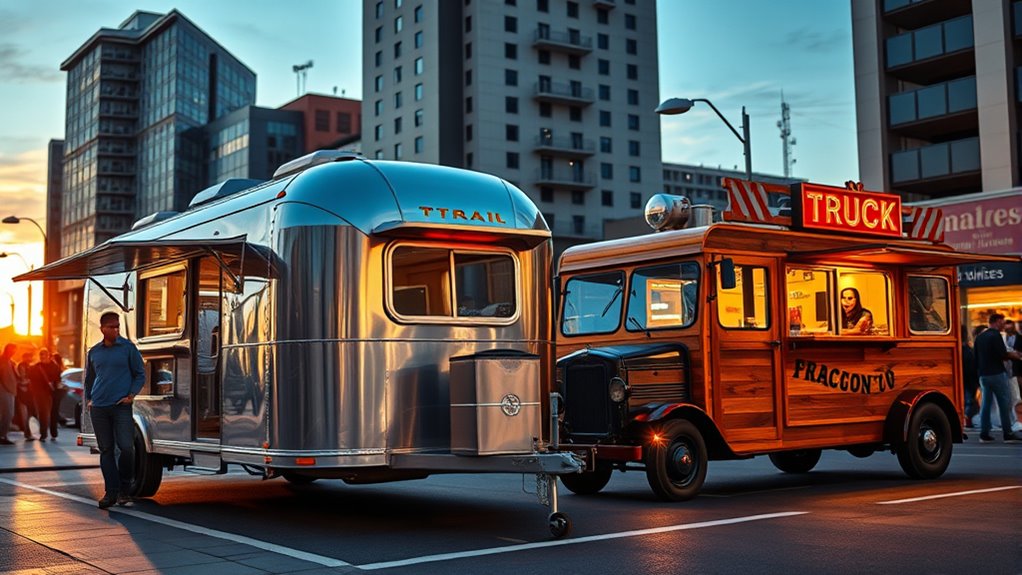
When deciding whether to buy or build a food truck, understanding the cost considerations and budgeting is vital. A key factor is the menu variety you want to offer, which influences equipment and ingredient costs. Building your own truck may allow you to customize for specific menu items, but it can also lead to higher expenses if you’re not careful. On the other hand, buying a pre-made truck might be more budget-friendly initially but could limit your menu options. Strong supplier relationships are essential regardless of your choice, as they impact ingredient costs and reliability. Additionally, understanding Cake Pops and their decoration options can help diversify your menu and appeal to a wider customer base. Budgeting carefully helps guarantee you can cover ongoing expenses like maintenance, supplies, and staffing. Incorporating virtual collaboration tools can streamline planning and communication during your build process, especially if working with remote partners or designers. Considering regulatory compliance and safety standards is also crucial to avoid penalties and ensure sustainable operations. Knowing these financial aspects upfront helps you make a smarter decision aligned with your business goals.
Customization and Design Flexibility
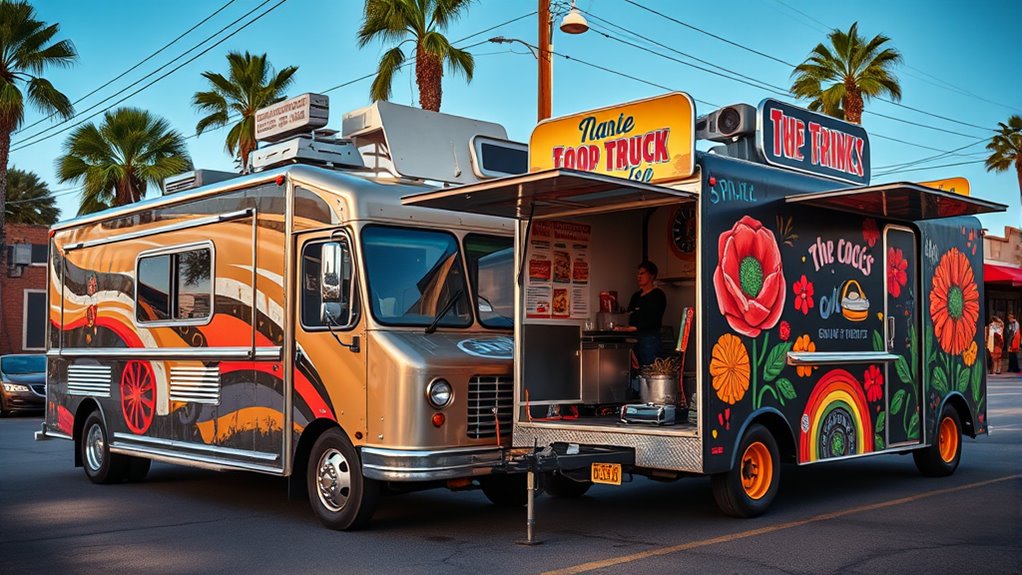
When choosing between buying or building your food truck, customization lets you showcase your personal style and stand out. You can optimize the layout to improve workflow and efficiency, making sure everything runs smoothly. Plus, selecting custom equipment allows you to tailor the truck to your specific menu needs. Incorporating self watering plant pots concepts such as adaptable and modular design can also inspire innovative solutions for internal storage and setup. Additionally, considering local business hours can help plan maintenance and setup times to ensure the truck operates seamlessly during peak hours. Emphasizing design flexibility can further enhance your ability to adapt the truck layout to changing needs and preferences. Employing a modular approach to design can facilitate easier updates and reconfigurations as your business evolves, similar to how adaptable electric bike conversion kits offer versatile solutions for different riding needs.
Personal Style Expression
Choosing between buying or building a food truck gives you the chance to create a vehicle that truly reflects your personal style. When customizing your truck, you can select unique exterior designs, colors, and branding strategies that set you apart. If you construct your own, you have full control over ingredient sourcing, allowing you to highlight specific themes or culinary niches that match your brand identity. This level of personalization helps communicate your vision directly to customers. Whether you buy or build, you can tailor the truck’s appearance and messaging to match your style, making it memorable and authentic. Your personal touch in design and ingredient sourcing ensures your food truck stands out, creating a cohesive brand that resonates with your target audience. To maintain motivation and overcome challenges during this process, it’s helpful to set achievable goals and develop consistent habits that keep your project moving forward. Additionally, understanding the importance of contingency plans can help you prepare for unexpected setbacks during your customization journey. Incorporating culinary branding strategies, such as unique menu items or signature flavors, can further strengthen your truck’s identity and attract loyal customers. Paying attention to color theory can also enhance your truck’s visual appeal and attract more customers, especially when combined with thoughtful design elements inspired by decorative themes.
Layout Optimization Options
Personal style isn’t just about appearances; it also extends to how your food truck is designed for efficiency and flow. You can customize your layout to optimize movement, storage, and customer interaction, ensuring smooth operations. Incorporating a mobile app can streamline ordering, reducing congestion and wait times. When designing your menu, consider how the layout supports quick access to ingredients and equipment. Use this table to visualize layout priorities:
| Aspect | Focus | Benefit |
|---|---|---|
| Workflow | Efficient movement | Faster service |
| Storage | Maximized space utilization | Less clutter, easier access |
| Customer Flow | Clear ordering path | Improved customer experience |
Tailoring your design enhances efficiency and customer satisfaction, making your food truck stand out. Additionally, understanding regional resources and legal considerations can help you navigate permits and regulations effectively. It’s also beneficial to explore innovative tableware concepts that can improve the presentation of your food and create a memorable dining experience for your customers. Design flexibility allows for adjustments based on customer feedback and changing menu offerings, ensuring your truck remains adaptable and competitive. A well-planned layout can also contribute to clutter reduction, fostering a more organized and stress-free working environment. Moreover, integrating efficient workflow strategies can significantly boost overall productivity and reduce operational stress.
Custom Equipment Choices
Custom equipment choices give you the flexibility to tailor your food truck to your specific needs and style. You can select appliances and fixtures that optimize your menu options, whether that’s specialized grills, fryers, or refrigeration units. This control allows you to craft a kitchen setup that maximizes efficiency and food quality. Additionally, custom equipment provides branding opportunities, such as branded cooking surfaces or eye-catching display cases that reflect your identity. Building your own truck means you can incorporate unique features that set you apart from competitors. It also ensures that every piece of equipment aligns with your operational goals, making your food truck truly yours. Choosing specialized appliances can help you meet specific menu requirements and improve overall performance. This level of customization enhances both functionality and the visual appeal of your mobile business. Considering equipment layout during customization can further optimize workflow and safety in your kitchen. Moreover, selecting equipment with energy efficiency can reduce operating costs and environmental impact over time. Integrating smart technology into your equipment can also improve monitoring and maintenance, ensuring consistent performance. Additionally, custom equipment options can include vintage-inspired fixtures, adding unique character to your truck’s design.
Time Investment and Speed to Market
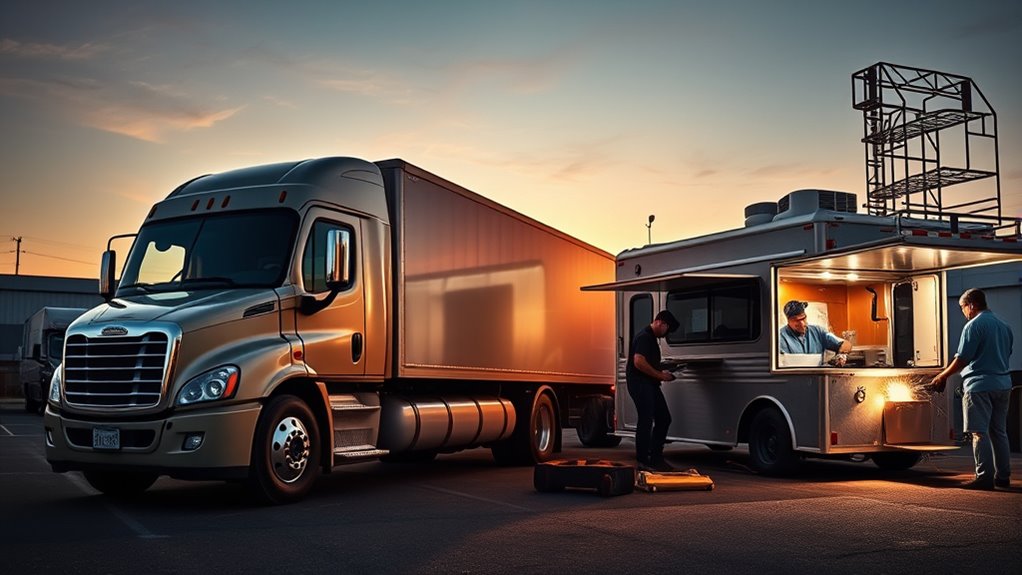
When deciding between buying or building a food truck, you’ll notice that construction timelines can vary considerably. Customization speed often limits how quickly you can get your truck ready for operation, especially with building from scratch. Ultimately, your deployment readiness pace depends on how quickly you need to hit the market and how much time you’re willing to invest.
Construction Timeline Differences
Building a food truck from scratch typically takes longer than buying a pre-existing one, mainly because of the time required for design, fabrication, and customization. The construction process involves multiple stages, which can vary in duration based on your specific needs and supplier efficiency. This leads to less timeline flexibility, meaning delays are more common as you coordinate each step. When you build, you’re responsible for overseeing the entire process, which can extend your timeline considerably. In contrast, buying a ready-made truck shortens your path to market, as the vehicle is already constructed and equipped. The difference in construction timelines impacts your overall speed to launch, making buying a quicker option if you need to start serving customers fast.
Customization Speed Constraints
The speed at which you can customize a food truck considerably affects your overall time to market. If you choose to build your own truck, menu customization can take longer, as you need to design and install equipment tailored to your specific dishes. Branding options, such as logos, wraps, and signage, also require additional time for design and application. These customization steps often involve multiple revisions and coordination with vendors, slowing down your launch schedule. Conversely, buying a pre-built truck with existing features can streamline this process, allowing you to hit the streets faster. However, if you want a highly personalized setup, building offers more flexibility but demands more time investment upfront. Ultimately, your customization speed directly impacts how quickly you can start serving customers.
Deployment Readiness Pace
Choosing between buying and building a food truck directly impacts how quickly you can become operational. Buying a truck usually means faster deployment, as it’s pre-built and ready for mobile branding and regional regulations compliance. Building your own takes longer, since it involves design, permits, and customization.
| Aspect | Buying | Building | Time to Market |
|---|---|---|---|
| Mobile Branding | Ready-made branding options | Custom branding setup | Faster for buying |
| Regional Regulations | Already compliant | Must obtain permits | Longer process |
| Deployment Speed | Quick launch | Delayed launch | Substantially longer |
In short, buying minimizes delays, while building offers tailored features but requires more time and effort to meet regional regulations and incorporate your mobile branding.
Quality Control and Build Standards
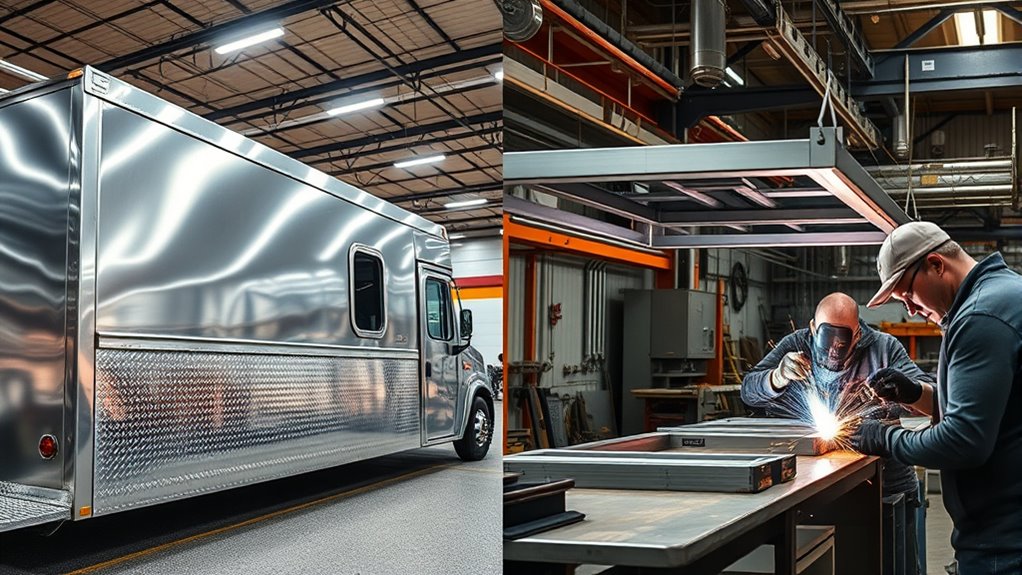
Ensuring quality control and adhering to build standards is essential whether you decide to buy or build a food truck. When focusing on quality, you guarantee that your truck meets safety and performance benchmarks, which directly impact your menu variety and customer satisfaction. A well-built truck provides a stable platform for preparing diverse dishes, helping you expand your menu options. Build standards also influence branding opportunities; a professionally constructed truck creates a strong visual impression and reinforces your brand identity. If you build your own truck, you control every detail, ensuring consistent quality. Conversely, buying a pre-made truck means verifying it already meets industry standards. Either way, maintaining high quality and strict build standards helps you deliver a reliable, attractive, and functional food truck.
Maintenance, Durability, and Longevity
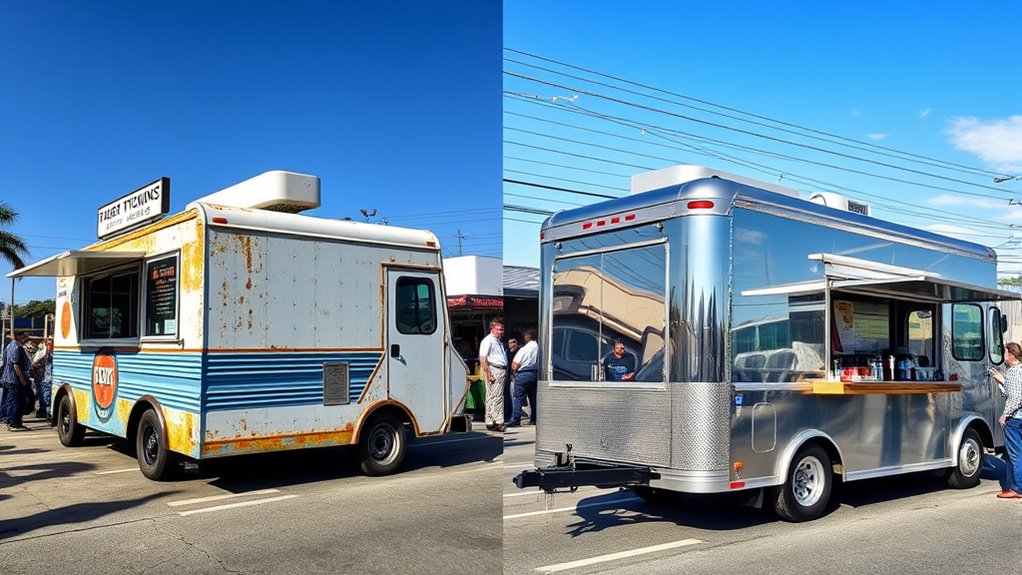
Maintaining your food truck’s condition is essential to maximize its lifespan and guarantee reliable performance over time. Regular upkeep, such as checking mechanical parts and cleaning surfaces, helps prevent costly repairs and ensures durability. A well-maintained truck also offers ample branding opportunities, keeping your appearance fresh and appealing to customers. Investing in quality materials and proper maintenance supports longevity, allowing you to serve the community longer and build stronger engagement. Durable equipment reduces downtime, enabling you to focus on growth rather than repairs. Consistent maintenance not only preserves the truck’s value but also demonstrates your commitment to quality, strengthening your presence in the community. Ultimately, a well-cared-for food truck enhances your reputation and sustains your business over the long term.
Long-Term Growth and Scalability
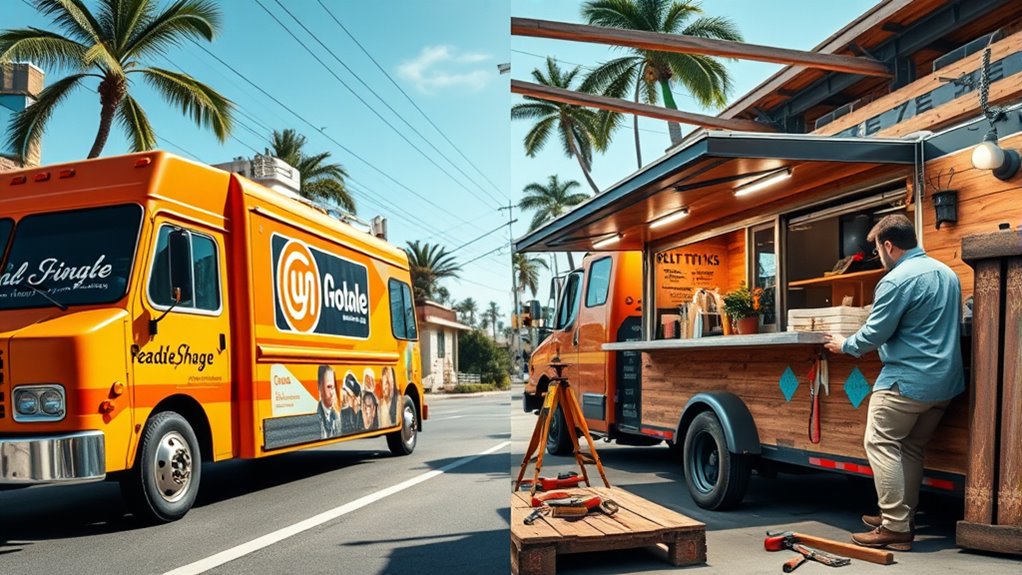
Long-term growth and scalability are crucial considerations when deciding between buying and building a food truck. You need to think about how your business can evolve, especially in areas like menu innovation and branding opportunities. When building your own truck, you gain the flexibility to customize features that support future expansion, such as:
Building your own food truck offers flexibility for future growth and branding opportunities.
- Implementing new menu ideas easily
- Rebranding or updating visuals for different events
- Adding equipment or space for increased staff
This adaptability allows your brand to grow with demand, making scalability smoother. Conversely, buying a pre-made truck might limit customization options, potentially hindering your ability to innovate and expand. Ultimately, building offers a tailored foundation for sustained growth, ensuring your food truck remains competitive and adaptable long-term.
Frequently Asked Questions
Which Option Offers Better Resale Value?
When considering resale value, the resale market plays a big role. Generally, buying a pre-owned food truck can offer better resale value because it’s already established and may have a higher value appreciation over time. Building your own might have initial costs but can depreciate quickly if the market shifts or if the truck isn’t as appealing. So, opting for a used truck often provides better resale potential and helps you retain more value.
How Do Licensing and Permits Differ Between Buying and Building?
Licensing and permits are your roadmap through the legal maze of food trucks. When you buy, the process is like taking a shortcut—you’ll often inherit existing licenses, but may face inspection requirements and permit fees that need updating. Building your own means starting fresh, maneuvering new permits, and passing inspections from scratch. Either way, understanding these differences helps you steer clear of surprises and keep your food truck journey on track.
What Are the Hidden Costs in Each Approach?
When considering hidden costs, you need to focus on cost estimation and vendor negotiations. For buying, unexpected expenses may include inspection fees, transportation, and initial repairs. Building your own truck involves costs like custom parts, specialized labor, and permits. Both approaches can surprise you with maintenance, insurance, and upgrades. Carefully analyze vendor negotiations and factor in these hidden costs to make an informed decision and avoid budget overruns.
How Does Each Option Impact Operational Flexibility?
Operational flexibility depends on your choice. If you build your own truck, you get customization options tailored to your needs, making adjustments easier as your business grows. Buying a truck offers quicker fleet integration, allowing you to expand faster, but it might limit customization. Your decision impacts how easily you can modify equipment or layout, influencing how well your food truck adapts to changing demands or new menu offerings.
Which Choice Minimizes Downtime During Setup or Repairs?
Ironically, your biggest hassle isn’t the busy days but the downtime during setup or repairs. You want to keep things rolling, yet maintenance costs and limited customization options can cause unexpected delays. Buying a ready-made truck often minimizes downtime, while building your own might seem appealing but can lead to longer repair times. So, if you value quick turnaround and less hassle, buying could be your best bet.
Conclusion
Choosing between buying or building your food truck is like steering a ship—you can buy a ready-made vessel to set sail quickly, or build your own from the keel up, customizing every feature. Either way, your journey depends on your vision, budget, and patience. Just remember, whether you’re steering familiar waters or charting a new course, staying true to your goals will help you reach your destination of food truck success.
